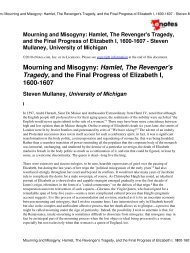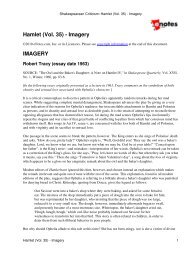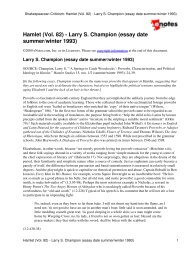Literary Criticism Research Paper – 150 points - The House of Ideas
Literary Criticism Research Paper – 150 points - The House of Ideas
Literary Criticism Research Paper – 150 points - The House of Ideas
Create successful ePaper yourself
Turn your PDF publications into a flip-book with our unique Google optimized e-Paper software.
Cornelius / AP Classes<strong>Literary</strong> <strong>Criticism</strong> <strong>Research</strong> <strong>Paper</strong> <strong>–</strong> <strong>150</strong> <strong>points</strong>AP Literature Due Date: December 13, 2012 <strong>–</strong> Turnitin.com 11:59 PMAP Language Due Date: January 1, 2013 <strong>–</strong> Turnitin.com 11:59 PMWhat is it? <strong>The</strong>re are many different critical approaches to literature (or “schools <strong>of</strong> criticalthought”). <strong>The</strong> goal <strong>of</strong> all <strong>of</strong> these types <strong>of</strong> criticism is to help readers explore a work <strong>of</strong> literaturemore deeply and to appreciate it as a “multilayered construct <strong>of</strong> meaning”; as a result <strong>of</strong> literarycriticism, readers are able to recognize the “social and cultural implications” <strong>of</strong> a work (Kaston etal).What are the types <strong>of</strong> literary criticism? <strong>The</strong>re are numerous forms; however, the ones we willbe relating to Hamlet are:Formalist (New <strong>Criticism</strong>)New Historicism (Historical)Psychoanalytic (Freudian)Feminist (Gender)Mythological/Jungian (Archetypal)What is the assignment? You will choose one type <strong>of</strong> literary criticism to focus on for yourresearch paper; your thesis and type <strong>of</strong> research will vary dramatically based on the school <strong>of</strong>literary thought that you select. After gathering sources, you will move quickly through theresearch process gathering data both from the play and outside research and writing your 5-6 page(not including Works Cited page) final draft.Assignment Details: No Late <strong>Paper</strong>s. Period. DO NOT PROCRASTINATE. Do not wait until the last minute to request help! This paper must be written in MLA format. Failure to do so will result in a decrease in grade. You must include several parenthetical references to support your thesis throughout your paper. You must have a Works Cited page listing FIVE sources - one <strong>of</strong> those MUST BE the text <strong>of</strong>Hamlet. Your paper MUST BE submitted to TURNITIN.COM by the due date AND a paper copy MUST BE TURNED IN BY THE DUE DATE.IMPORTANT: No Wikipedia or Sparks Notes types <strong>of</strong> sources can be included in your WorksCited. <strong>The</strong>se are not considered scholarly. You may use the sources on my webpage if you sochoose. Any plagiarism will result in a zero on this assignment.
Cornelius / AP Classes<strong>Literary</strong> <strong>Criticism</strong> #1: FormalismFormalists focus on the structure (or FORM), <strong>of</strong> the literary work. <strong>The</strong>y are much moreinterested in the use <strong>of</strong> language than the content (i.e., they study the use <strong>of</strong> puns and alliterationinstead <strong>of</strong> plot and conflict). This is the school <strong>of</strong> criticism used in AP Literature.Formalists try to be objective in their analysis and disregard external issues that others <strong>of</strong>tentake into consideration when studying literature, such as the history and politics <strong>of</strong> when thework was written.Formalists believe that great writers move beyond boring everyday speech to use language in acreative, unexpected way that causes the reader to think differently about life. <strong>The</strong>y study theliterary elements and interesting patterns <strong>of</strong> language that a writer uses.Formalists believe that a work <strong>of</strong> literature is an art form in itself, and it is not symbolic <strong>of</strong> theauthor’s or society’s beliefs.Homework Questions:1) How does Hamlet’s language change during the course <strong>of</strong> the soliloquies, and what does this revealabout his state <strong>of</strong> mind? (Examine the first soliloquy and compare it to later soliloquies).2) Why does Hamlet choose to use puns with certain characters and double entendres with others?What does this illustrate about his morals and goals?3) <strong>The</strong>re are many examples <strong>of</strong> repetition and echoing in the play (i.e., the ghost echoing Hamlet’searlier words, Hamlet repeating Gertrude’s lines but putting his own twist on them, and the repeatedmentioning <strong>of</strong> ears and acting terminology). Choose one or more <strong>of</strong> these to explore in detail. Whatis the purpose <strong>of</strong> this?
Cornelius / AP Classes<strong>Literary</strong> <strong>Criticism</strong> #2: New HistoricismNew Historicism emerged in the 1980’s as a response to formalism. Although new historicistsacknowledge the importance <strong>of</strong> literary elements in writing, they believe it is just as importantto examine what was going on in the world when the literary work was written.Whereas Historical criticism (in the 1930s and 1940s) was very objective and fact-oriented, newhistoricists believe that history is less clear-cut. <strong>The</strong>y acknowledge that we have beenconditioned by our own society to believe specific things about the past, so our historicalreading <strong>of</strong> a text is always a bit skewed. However, they still think it is important to read a workin the context <strong>of</strong> its own society.Many new historicists utilize the ideas <strong>of</strong> the French philosopher historian, Michel Foucault,who believed that no historical event had only one cause. Instead, Foucault stated that eachevent in history was caused by the interaction <strong>of</strong> factors stemming from politics, economy, andsocial beliefs <strong>of</strong> the time.Homework Questions:1) What was going on in the Royal family during Shakespeare’s time? Does his depiction <strong>of</strong>Claudius and Gertrude relate in any way to corruption he witnessed first-hand?2) How did Shakespeare’s society view marriages that we deem “incestuous” today? Modernreaders can understand why Hamlet is so disgusted by his mother’s marriage to Claudius, butwould readers during Shakespeare’s time think he was overreacting?3) How was mental illness viewed and treated during the Renaissance? What would the likelyresponse be to Hamlet and Ophelia’s “madness,” and did the characters in the play respond in the“proper” way, according to their society?
Cornelius / AP Classes<strong>Literary</strong> <strong>Criticism</strong> #3: Psychoanalytic (Freudian)Type A:Reading and interpretation are limited to the work itself. <strong>The</strong> reader examines conflicts, characters, dreamsequences, and symbols. <strong>The</strong> Oedipus Complex may operate on a subconscious level for one or morecharacters (i.e., the father and son compete for the mother’s attention). Characters’ personalities are affectedby the three parts <strong>of</strong> the subconscious:Id <strong>–</strong> Known as the “inner child,” the id is the basic desire for what each person wants. <strong>The</strong>re is nosense <strong>of</strong> conscience in it. For instance, most <strong>of</strong> us know that even if we really want the deliciouslookinglunch the stranger at the next table ordered, we can’t just take it from him and eat itourselves. Someone who is controlled by his or her id, however, would do just that.Superego <strong>–</strong> <strong>The</strong> opposite <strong>of</strong> the id, the superego contains our sense <strong>of</strong> guilt and knowledge <strong>of</strong>societal expectations. We gain the superego by having our parents and other members in societyscold or criticize us.Ego <strong>–</strong> <strong>The</strong> balance between the id and superego, the ego represents reality. It takes the desires <strong>of</strong> theid, filters them through the superego, and comes up with an action that satisfies both. <strong>The</strong> egorealizes that the id must be satisfied, but that there are socially accepted ways to achieve satisfaction.If a character’s subconscious is unbalanced and favors either the id or the superego, their behaviormay be deemed as inappropriate by his or her society.Type B:An important relationship exists between the author and the work itself. To understand a work <strong>of</strong> literature,the reader must understand the author’s life and beliefs. Not all works are autobiographical, butpsychoanalysts feel that there is always something <strong>of</strong> the author in a text. Authors <strong>of</strong>ten satirize or mockpeople they dislike, or are sympathetic to people they do like. Readers can infer the author’s beliefs byreading a text, or may utilize what is already known about the author’s life by using it to understand a work.A writer may put his or her repressed desires in the work through the actions performed by the characters.For instance, an author who depicts all lower-class characters as foolish, weak, and disloyal may beexpressing repressed discriminatory beliefs towards the poor.Homework Questions:1) Examine how the subconscious <strong>of</strong> Hamlet, Fortinbras, and Laertes make them foils for one another.Which part <strong>of</strong> the subconscious leads each character? Explain.2) What was happening in Shakespeare’s own life during or before he wrote Hamlet? What grief <strong>of</strong> hisown might he have been expressing through his play? Explain.3) Contrast the outcomes <strong>of</strong> a few major characters (i.e., Hamlet and Claudius). Did they get what thedeserved? Did they achieve their goals? What might this reveal about Shakespeare’s own beliefs?
Cornelius / AP Classes<strong>Literary</strong> <strong>Criticism</strong> #4: Feminist<strong>The</strong> feminist theory <strong>of</strong> literary criticism emerged in the 1960’s, and it is based on the concept that theWestern world has been traditionally patriarchal (created by men, ruled by men, and judged by men). As aresult, feminists believe that most literature reflects a masculine bias and presents an inaccurate andsometimes harmful view <strong>of</strong> women.Feminist critics may try to find suggestions <strong>of</strong> misogyny (negative attitudes about women) within literatureand expose them. Readers can do this by studying how female characters are portrayed or by examining thepatriarchal ideas or male dominance that is shown in a classic work <strong>of</strong> literature.Feminist critics sometimes also examine how the men are portrayed <strong>–</strong> are male characters shown in astereotypical way, or do they break out <strong>of</strong> the traditionally male label. <strong>The</strong> feminist school <strong>of</strong> thoughtexamines the power relationships and struggles between men and women in literature and explores how maleand female characters interact in their relationships.Feminist critics believe that the female personality must be judged by different measures than the malepersonality. In other words, a characteristic such as “strength” manifests itself differently in males thanfemales.Homework Questions:1) Do Gertrude and/or Ophelia have any power in Hamlet? If so, is it political, economic, social, orpsychological? Explain. Do they serve important functions in the plot or not?2) In what acts <strong>of</strong> rebellion, if any, do Ophelia and Gertrude participate? What are the results for each<strong>of</strong> them when they rebel? What does this reveal about Shakespeare’s, or his society’s, views aboutwomen?3) Do Gertrude and/or Ophelia have options within their society? How were women viewed andtreated during Shakespeare’s time? How does this impact how they “should” be acting towardsPolonius, Claudius, Hamlet, etc.?
Cornelius / AP Classes<strong>Literary</strong> <strong>Criticism</strong> #5: Mythological (aka Archetypal)Sigmund Freud’s student, Carl Jung, defined an archetype as “a figure…that repeats itself in the course<strong>of</strong> history wherever creative fantasy is fully manifested.” He believed that all people are born with anunderstanding <strong>of</strong> certain archetypes. Archetypes exist in literature in the form <strong>of</strong> common types <strong>of</strong>characters (i.e., “the corrupt leader”), situations (i.e., “the epic journey”), and images or symbols (i.e.,water as a symbol for purification).Similarly, many myths are repeated throughout history and across cultures (such as the origin <strong>of</strong> life,what happens after death, etc.).When authors utilize myths or archetypes, they allow readers to connect with a character or plot withlittle or no explanation. For instance, writers frequently use archetypes as minor characters because thenthey do not need to provide as many details about them.Mythological or archetypal literary critics look for symbols in the work. It can be just as significant if asymbol in a work seems to represent something other than its typical archetypal meaning (i.e., what ifwater represented corruption rather than purification?).<strong>The</strong>se critics also search for archetypal characters. Common types include the hero, the scapegoat, theoutcast, the temptress, and the intellect. Critics then determine whether or not a character fits neatly intothe archetype and, if not, they explore why this may be the case.Finally, mythological critics identify archetypal situations in a literary work. <strong>The</strong>se include: the quest,the renewal <strong>of</strong> life, initiation/rites <strong>of</strong> passage, loss <strong>of</strong> innocence, and redemptive sacrifice. Critics thendiscuss the significance <strong>of</strong> this situation in the context <strong>of</strong> the work.Homework Questions:1) Is Hamlet an archetypal hero? If not, why does Fortinbras order a hero’s burial for him at theend <strong>of</strong> the play?2) Some mythological critics view Claudius and Gertrude as a distorted version <strong>of</strong> Adam and Eve.Why might this be the case? Do you agree or disagree?3) How is the natural world (i.e., gardens, flowers, etc.) used as a symbol in the play? Does thiscorrespond to its archetypal symbolic meaning or not? Explain.











